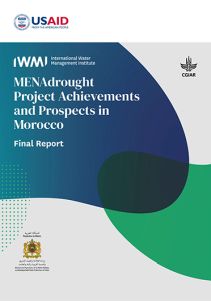 MENAdrought Project Achievements and Prospects in Morocco
MENAdrought Project Achievements and Prospects in Morocco
MENAdrought is a demand-led applied research and technical support project whose objective is to aid the project countries in building self-reliance in managing the impacts of drought on water and food security in order to limit social and economic losses.1 It came into being following the High-Level Meeting on National Drought Policy (HMNDP) convened by the World Meteorological Organization (WMO) in 2013, where countries in the Middle East and North Africa (MENA) region sought technical support to improve drought monitoring and management in their water and agricultural systems.
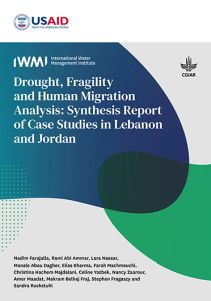 Drought, Fragility and Human Migration Analysis: Synthesis Report of Case Studies in Lebanon and Jordan
Drought, Fragility and Human Migration Analysis: Synthesis Report of Case Studies in Lebanon and Jordan
This report synthesizes two case studies that concerned the interactions between drought, fragility and human migration. The case study areas we selected are predominantly agricultural and have high sensitivity to drought impacts: Rechaya in southeastern Lebanon and parts of the Zarqa Governorate in Jordan. We used a mixed methods and systems approach that allowed us to explore the local dynamics within national and Levantine regional socioeconomic, political and environmental contexts.
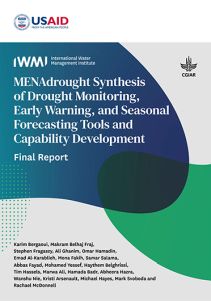 MENAdrought Synthesis of Drought Monitoring, Early Warning, and Seasonal Forecasting Tools and Capability Development
MENAdrought Synthesis of Drought Monitoring, Early Warning, and Seasonal Forecasting Tools and Capability Development
This report (Pillar 1) synthesizes the development of drought monitoring, early warning and seasonal forecasting tools and capabilities in the MENAdrought project countries of Jordan, Lebanon and Morocco. It focuses on how the MENAdrought team and national partners collaboratively and iteratively developed, tested, refined, applied and enabled the use of the enhanced Composite Drought Indicator (eCDI) drought monitoring product and seasonal forecasting tools in each country, and how these technologies are being embedded within relevant institutions. However, our report presents only minimal technical details and methods because they will be published separately.
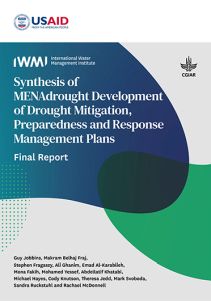 Synthesis of MENAdrought Development of Drought Mitigation, Preparedness and Response Management Plans
Synthesis of MENAdrought Development of Drought Mitigation, Preparedness and Response Management Plans
This report summarizes MENAdrought engagements with government agencies in Jordan, Lebanon and Morocco to support drought risk management. It describes the development process for, and the content of, Drought Action Plans (DAPs) that national and local government agencies have developed with MENAdrought support.
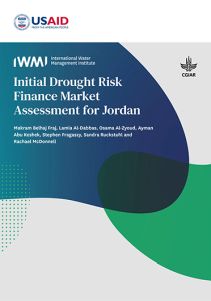 Initial Drought Risk Finance Market Assessment for Jordan
Initial Drought Risk Finance Market Assessment for Jordan
In Jordan, droughts have significant social and economic impacts on vulnerable and marginal farming communities including smallholder producers of cereals on rainfed lands, livestock integrators and transhumant herders, as well as smallholder greenhouse farms and commercial agribusinesses. Farmers need access to affordable financial products to mitigate and proactively respond to episodes of drought.
 Synthesis of the Rapid Drought Impact Assessment in Tafilah, Jordan
Synthesis of the Rapid Drought Impact Assessment in Tafilah, Jordan
The purpose of this MENAdrought study was to assess the agricultural impacts of the drought of 2020-2021 and advise on compensation for farmers in the Tafilah Governorate of Jordan. The Drought Technical Committee (DTC), a working group set up to manage drought risks, also used the study to validate and calibrate the Jordanian Drought Monitor for Badia (arid rangelands) areas and develop a repeatable survey tool and process for drought impact reporters to use in the future.
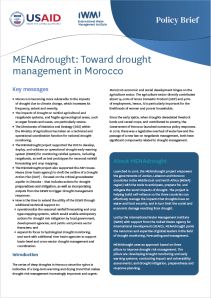 MENAdrought: Toward drought management in Morocco
MENAdrought: Toward drought management in Morocco
The series of deep droughts in Morocco since the 1980s is indicative of a long-term warming and drying trend that makes drought risk management increasingly important and urgent. Morocco’s economic and social development hinges on the agriculture sector. The agriculture sector directly contributes about 14–20% of Gross Domestic Product (GDP) and 40% of employment, hence, it is particularly important for the livelihoods of women and poorer households.
 MENAdrought: Toward drought management in Lebanon
MENAdrought: Toward drought management in Lebanon
Periods of drought in the MENA region have become more pronounced due to rising temperatures and changes in precipitation patterns caused by climate change. Water evaporates and transpires from plants faster, which contributes to the increased risk of droughts, as well as the length of drought periods. The impacts of droughts in MENA affect nearly every segment of society and sector in the economy, and they can have profound effects on livelihoods and households in the long term.
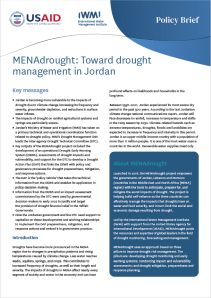 MENAdrought: Toward drought management in Jordan
MENAdrought: Toward drought management in Jordan
Droughts have become more pronounced in the MENA region due to changes in precipitation patterns and rising temperatures caused by climate change. Less water reaches wadis, aquifers, springs, and crops. This contributes to increased frequency of droughts, as well as their length and severity. The impacts of droughts in MENA affect nearly every segment of society and sector in the economy and can have profound effects on livelihoods and households in the long term.
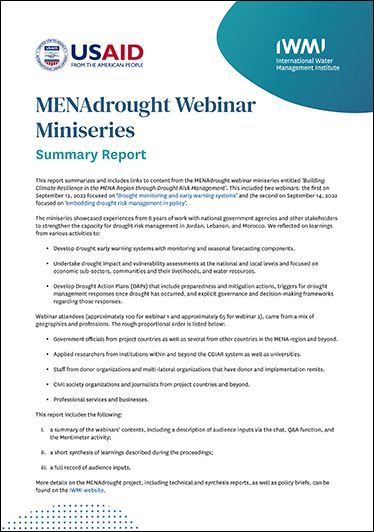 MENAdrought Webinar Miniseries: Summary Report
MENAdrought Webinar Miniseries: Summary Report
This report summarizes and includes links to content from the MENAdrought webinar miniseries entitled ‘Building Climate Resilience in the MENA Region through Drought Risk Management’. This included two webinars: the first on September 12, 2022 focused on ‘drought monitoring and early warning systems’ and the second on September 14, 2022 focused on ‘embedding drought risk management in policy’.
- How MENAdrought is strengthening drought resilience in the Middle East and North Africa
- MENAdrought project webinar 1: Drought monitoring and early warning systems
- Developing drought action plans for the Middle East and North Africa
- MENAdrought project webinar 2: Embedding drought risk management in policy
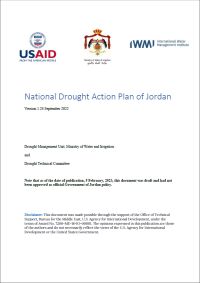 National Drought Action Plan of Jordan
National Drought Action Plan of Jordan
Drought is a slow-onset natural hazard with widespread economic, health and social impacts. With precarious water security and a hot climate, Jordan is highly vulnerable to drought. This document provides a practical guide for managing drought risk by the public authorities.
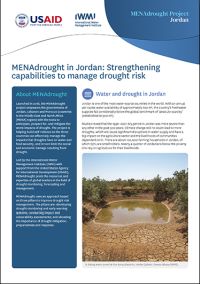 MENAdrought in Jordan: Strengthening capabilities to manage drought risk
MENAdrought in Jordan: Strengthening capabilities to manage drought risk
Jordan is one of the most water-scarce countries in the world. With an annual per capita water availability of approximately 100 m³, the country’s freshwater supplies fall considerably below the global benchmark of ‘absolute scarcity’ (established at 500 m³). Studies reveal that the 1998–2001 dry period in Jordan was more severe than any other in the past 500 years, and climate change will no doubt lead to more droughts. The MENAdrought project uses an approach based on three pillars to improve drought risk management.
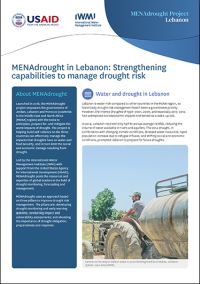 MENAdrought in Lebanon: Strengthening capabilities to manage drought risk
MENAdrought in Lebanon: Strengthening capabilities to manage drought risk
Lebanon is water-rich compared to other countries in the MENA region, so historically drought risk management hasn’t been a government priority. However, the intense droughts of 1998–2001, 2008, and especially 2013–2014 had widespread socioeconomic impacts and served as a wake-up call. In 2014, Lebanon received only half its annual average rainfall, reducing the volume of water available in rivers and aquifers. The MENAdrought project uses an approach based on three pillars to improve drought risk management.
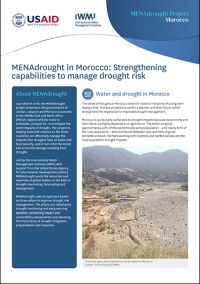 MENAdrought in Morocco: Strengthening capabilities to manage drought risk
MENAdrought in Morocco: Strengthening capabilities to manage drought risk
The series of droughts in Morocco since the 1970s is indicative of a long-term drying trend. Climate projections call for a warmer and drier future, which strengthens the imperative for improved drought management. Morocco is particularly vulnerable to drought impacts because its economy and labor force are highly dependent on agriculture. Farmers working with livestock and rainfed cereals are the most exposed to drought impacts. The MENAdrought project uses an approach based on three pillars to improve drought risk management.
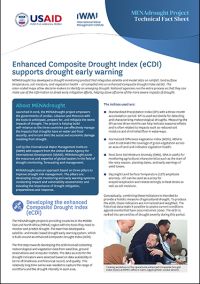 Enhanced Composite Drought Index (eCDI) supports drought early warning
Enhanced Composite Drought Index (eCDI) supports drought early warning
The MENAdrought project has developed a drought monitoring product that integrates satellite and model data on rainfall, land surface temperature, soil moisture, and vegetation health – all compiled into an enhanced Composite Drought Index (eCDI). The color-coded maps allow decision makers to identify an emerging drought. National agencies run the entire process so that they can make use of the information to direct early mitigation efforts, helping stave off some of the more severe impacts of drought.
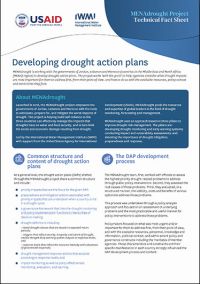 Developing drought action plans
Developing drought action plans
TThe MENAdrought project is working with the governments of Jordan, Lebanon and Morocco to develop drought action plans (DAPs). The project works ‘with the grain’ to help agencies consider what drought impacts are most important for them to address first, from their point of view, and how to do so with the available resources, policy context and constraints they face. The DAP development process was undertaken through a policy analysis approach and focused on an assessment of underlying problems and the most practicable and useful manner for policy interventions to address those problems.
 Developing an operational enhanced Composite Drought Index (eCDI) to support drought early warning in the Middle East and North Africa region
Developing an operational enhanced Composite Drought Index (eCDI) to support drought early warning in the Middle East and North Africa region
Experts predict that conditions will become drier and hotter across the Middle East and North Africa (MENA) region as climate change progresses. The MENAdrought project aims to provide Jordan, Lebanon and Morocco (countries in the MENA region) with the tools they need to anticipate, prepare for and mitigate the impacts of drought going forward.
English version | Arabic version
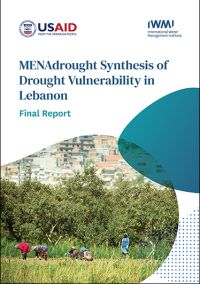 MENAdrought Synthesis of Drought Vulnerability in Lebanon
MENAdrought Synthesis of Drought Vulnerability in Lebanon
This report summarizes MENAdrought findings on the underlying causes of vulnerability to drought impacts in Lebanon. It serves as a link between the impact assessment and policy planning process.
The objective of the vulnerability studies has been to identify who or what is at risk from drought, what causes that risk, and the effects of how actors manage that risk. This can inform drought management planning so that interventions target underlying causes of vulnerability for the identified communities and systems.
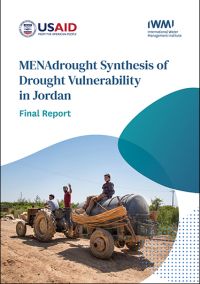 MENAdrought Synthesis of Drought Vulnerability in Jordan
MENAdrought Synthesis of Drought Vulnerability in Jordan
This report summarizes MENAdrought findings on the underlying causes of vulnerability to drought impacts in Jordan. It serves as a link between the impact assessment and policy planning process.
The objective of the vulnerability studies has been to identify who and what is at risk from drought, what causes that risk, and the effects of how actors manage that risk. This can inform drought management planning so that interventions target underlying causes of vulnerability for the identified communities and sectors.
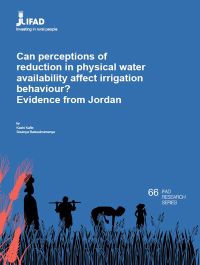 Research Series Issue 66: Can perceptions of reduction in physical water availability affect irrigation behaviour? Evidence from Jordan
Research Series Issue 66: Can perceptions of reduction in physical water availability affect irrigation behaviour? Evidence from Jordan
Frequent droughts and rapidly depleting groundwater reserves have deepened the water scarcity crisis in Jordan. Even though most farms use ‘water-saving’ technologies, groundwater depletion continues at an alarming rate.
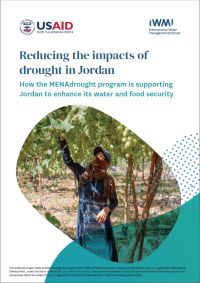 Reducing the impacts of drought in Jordan
Reducing the impacts of drought in Jordan
Climate disruption is making droughts more likely in the Middle East and North Africa (MENA) region, with related detrimental impacts on water and food security. Jordan is already one of the most water-scarce countries in the world. The MENAdrought project aims to empower decisionmakers and practitioners in Jordan with the tools and action plans needed to anticipate, prepare for and mitigate the worst impacts of drought.
English version | Arabic version
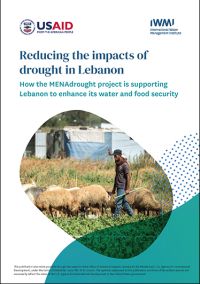 Reducing the impacts of drought in Lebanon
Reducing the impacts of drought in Lebanon
As climate change disrupts historical weather patterns, droughts are increasingly likely to have detrimental impacts on water and food security in the Middle East and North Africa (MENA) region. Despite its generally wetter conditions, Lebanon’s water security is challenged by various ongoing issues. The MENAdrought project aims to empower Lebanon with the tools to anticipate, prepare for and mitigate the worst impacts of drought.
English version | Arabic version
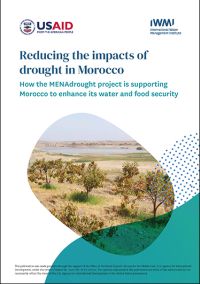 Reducing the impacts of drought in Morocco
Reducing the impacts of drought in Morocco
As climate change disrupts historical weather patterns, droughts are increasingly likely to have detrimental impacts on water and food security in the Middle East and North Africa (MENA) region. In Morocco, the change is already noticeable. Since the 1970s, extreme drought has become a more regular element of Morocco’s climate. The MENAdrought project aims to empower Morocco with the tools to anticipate, prepare for and mitigate the worst impacts of drought.
English version | Arabic version
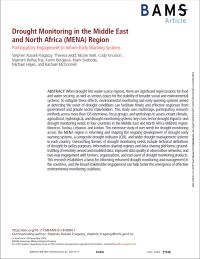 Drought Monitoring in the Middle East and North Africa (MENA) Region
Drought Monitoring in the Middle East and North Africa (MENA) Region
Citation
Fragaszy, S. R.; Jedd, T.; Wall, N.; Knutson, C.; Belhaj Fraj, M.; Bergaoui, K.; Svoboda, M.; Hayes, M.; McDonnell, Rachael. 2020. Drought monitoring in the Middle East and North Africa (MENA) region: participatory engagement to inform early warning systems. Bulletin of the American Meteorological Society (BAMS), 101(7):E1148-E1173. [doi: 10.1175/BAMS-D-18-0084.1]
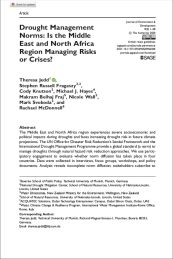 Drought Management Norms: Is the Middle East and North Africa Region Managing Risks or Crises?
Drought Management Norms: Is the Middle East and North Africa Region Managing Risks or Crises?
Citation
Theresa Jedd, Stephen Russell Fragaszy, Cody Knutson, Michael J. Hayes, Makram Belhaj Fraj, Nicole Wall, Mark Svoboda, and Rachael McDonnell [doi.org/10.1177/1070496520960204]
Media Coverage
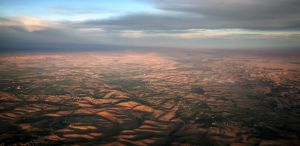 Strengthening Drought Monitoring Across the Middle East and North Africa
Strengthening Drought Monitoring Across the Middle East and North Africa
In one of the world’s most water-stressed regions, USAID and partners are helping create more resilient communities by preparing them to stay one step ahead of the next drought.






